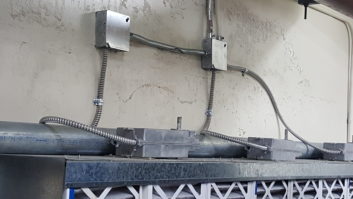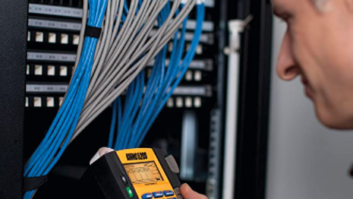
Before it starts to get too hot, now is a good time to check your cooling systems — both at the transmitter and for the studio and rack room.
Studio air handlers can be wedged above the actual studio or technical operations center, which can be a nightmare should the condensate drain get clogged with algae and then overflow.
Whether you do the maintenance yourself or you contract an HVAC company, schedule it now.
If you’re doing the work, remove the PVC cleanout cap atop the drain trap (shown in Fig. 1). With a bottle brush — buy one in the housewares/kitchen supply section of a grocery store — clean out the trap. Pour clean water down the trap as you go to speed the process. After cleaning, store the bottle brush next to the condensate drain, so it will be handy next time.
Once the trap is clean, I’ve seen some HVAC techs pour a little bleach into the drain. The big box stores sell an alternative, Air Conditioner Drain Pan Tablets. These tablets are placed in the drain pan and last about a month. Their chemical makeup prevents the buildup of algae, slime and scale, keeping the drain clear. Two hundred tablets run about $30; smaller quantities are available for about $1/tablet.
We write a lot about redundancy. In a large transmitter building, your cooling backup may consist of a second air conditioner. An alternative is forced air cooling, as pictured in Fig. 2, should the air conditioning fail.

An air vent, even if it’s filtered, would defeat the job the air conditioning does, so adding motorized louvers is recommended. As shown in Fig. 3, the louvers are controlled by a thermostat, which drives a motor to open them when high temperature is detected. You’ll probably need to remove the air filters to inspect the operation of this seldom-used backup system. Maintenance includes lubricating the linkage that controls the louvers, and watching for smooth operation as the louvers open and close.

If you’re not using high-efficiency air filters, as in Fig. 2, consider doing so; they’re worth the extra cost. We don’t get to transmitter sites as often as we used to, and these filters will keep your equipment cleaner. While you’re at it, measure the filter sizes of your transmitters and convert them to the higher-efficiency filters as well.
You can reduce cost by buying in bulk. Once you have your filter sizes, search online for bulk air filters. Of course, Amazon sells a variety, but also check acFilters4Less.com; they offer free shipping.
We’ve mentioned this before but it bears repeating: With so many sites to cover, keeping track of the filter change dates can be difficult. With a Sharpie-type permanent marker, write the date of install on the new filters. Depending on the local conditions, plan on inspecting their condition every month and replacing as needed. Most sites can get by with a quarterly filter change.
You’ll find a variety of air conditioning maintenance videos online — just search for air conditioning maintenance.
***
Veteran San Francisco contract and projects engineer Bill Ruck enjoyed reading Frank Hertel’s tips regarding rodent control in transmitter buildings. Bill adds two things.
First, regarding rat poison. A poisoned rodent goes looking for water and may die outside. The body is then eaten by one of their natural predators, and the poison kills the predator. Natural predators like coyotes and raptors control rodents for free, so think hard about the effects of using poison.
Engineers will find this useful: Bill’s wife Siobhan shared a website called R.A.T.S., which stands for Raptors Are The Solution. Their home page www.raptorsarethesolution.org encourages you not to use toxins for controlling rodents. As you will read, poison not only kills birds of prey, but also dogs and cats.
Consider alternatives.
If you feel it necessary to kill rodents, Bill suggests snap traps. Bill is one of many volunteers at the KPH Project, the Maritime Radio Historical Society. The National Park Service, which owns the society’s sites, prohibits the use of poison, so Bill says they had to seek out alternatives. They have found that electric traps also work well, especially for larger rodents.
Bill’s second point refers to airborne disease. He says Frank was lucky that he only got a bacterial infection and not Hantavirus after his rodent experience.
There is no cure for Hanta, and the mortality rate is 38%. Keep that in mind if you encounter a site littered with mouse droppings.
Bill offers a suggestion when cleaning up mouse droppings: First, wet them down with a dilute chlorine bleach solution. It’s best to wear a respirator. Then, wear gloves and use paper towels to clean up the mess. Dispose of the used towels carefully, preferably in a plastic bag that you seal.
There’s useful information about Hantavirus on Wikipedia and the Centers for Disease Control. He also recommends a PDF from the CDC. It explains Hantavirus, how it’s spread and safe procedures to clean up, should you encounter a rodent infestation.
Bill concludes that the best overall long-term solution for mice infestations is to follow Frank’s tips for prevention, especially never leaving any food or drinks or anything that smells of food (like fast food wrappers) in your transmitter building. Practice good housekeeping.
John Bisset has spent over 50 years in the broadcasting industry and is still learning. He handles western U.S. radio sales for the Telos Alliance. He holds CPBE certification with the Society of Broadcast Engineers and is a past recipient of the SBE’s Educator of the Year Award.




